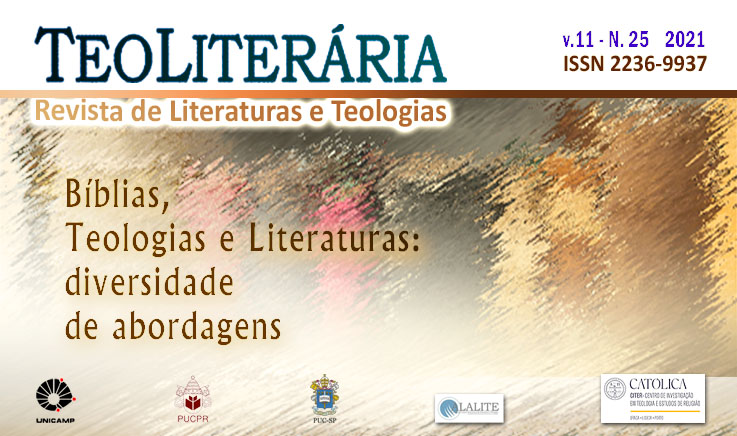A compaixão do pai no centro do enredo da parábola do filho perdido e reencontrado (Lc 15,11-32)
DOI:
https://doi.org/10.23925/2236-9937.2021v25p106-131Palabras clave:
Evangelho de Lucas, parábola, análise narrativa, filho pródigo, filho perdido e reencontradoResumen
Este artigo objetiva investigar a parábola do filho perdido e reencontrado (Lc 15,11-32), mais conhecida como do “filho pródigo”, pelo método da análise narrativa, demonstrando a centralidade da compaixão paterna na perícope. A análise do narrador segue as categorias de Genette e os demais operadores de leitura da narrativa são analisados a partir de Ska e de Marguerat e Bourquin. O enredo foi divido em três cenas, as quais colocam os personagens em relação com a casa paterna e com o próprio pai. No enredo, a atitude de “mover-se de compaixão” (v. 20) configura-se como o ponto de mudança da narrativa, pois dá início a uma série de transformações que solucionam o conflito da trama. Lucas constrói um jogo de releituras e analepses que colocam em posição central a acolhida do pai ao filho. Pelo efeito de acúmulo construído pelo uso de três parábolas em uma sequência narrativa, e pela identificação do narrador e narratário intradiegéticos, fica claro que a opção do relato não é pela proposta de rechaço feita pelo filho mais velho, mas pela compaixão do pai, já que a própria opção de Jesus é acolher os pecadores e com eles compartilhar a vida (Lc 15,3).Citas
BOCK, P. L. Luke 1:1–9:50. Grand Rapids: Baker Academic, 1994.
BOVON, F. El Evangelio según San Lucas. Vol. III. Salamanca: Sígueme, 2005.
CATENASSI, F. Z.; PERONDI, I. Bíblia e ciências da linguagem: recursos literários e cenas-tipo no Evangelho de Lucas. Teoliterária, São Paulo, v. 9, n. 17, 2019: 338-358. https://revistas.pucsp.br/index.php/teoliteraria/article/view/39397/28507
DRURY, J. Lucas. In: ALTER, R.; KERMODE, F. Guia literário da Bíblia. São Paulo: Fundação da Editora da Unesp, 1997, p. 449-471.
FITZMYER, J. A. El Evangelio según Lucas. Vol. III. Madrid: Cristiandad, 1986.
FUNK, R. W. The poetics of Biblical narrative. Sonoma: Polebridge Press, 1988.
GENETTE, G. O discurso da narrativa. 3. ed. Lisboa: Veja, 1995.
GOURGES, M. As parábolas de Lucas: do contexto às ressonâncias. São Paulo: Loyola, 2005.
GREEN, J. B. The gospel of Luke. Grand Rapids: Eerdmans, 1997. (The New International Commentary on the New Testament).
HARNISCH, W. Las parábolas de Jesús: una introducción hermenéutica. Salamanca: Sígueme, 1989.
HENRIQUES, C. C. Estilística do discurso. Rio de Janeiro: Elsevier, 2011.
JEREMIAS, J. Las parábolas de Jesús. 3. ed. Estella: Verbo Divino, 1974.
KERMODE, F. Introdução ao Novo Testamento. In: ALTER, R.; KERMODE, F. Guia literário da Bíblia. São Paulo: Fundação da Editora da Unesp, 1997, p. 403-415.
LEONEL, J.; TONIOLO, R. C. As voltas do filho pródigo, de Autran Dourado, e a parábola bíblica. Cerrados, Brasília, v. 29, n. 53, 2020: 250-283. https://periodicos.unb.br/index.php/cerrados/issue/view/1944/529
MARGUERAT, D.; BOURQUIN, Y. Para ler as narrativas bíblicas: iniciação à análise narrativa. São Paulo: Loyola, 2009.
MARSHALL, I. H. The gospel of Luke. Carlisle: The Paternoster, 1978.
MENDONÇA, J. T. A construção de Jesus: a dinâmica narrativa de Lucas. São Paulo: Paulinas, 2019.
PERONDI, I. A compaixão de Jesus com a mãe viúva de Naim (Lc 7,11-17): o emprego do verbo splangxizomai na perícope e no Evangelho de Lucas. Tese (Doutorado em Teologia Bíblica). Rio de Janeiro: Pontifícia Universidade Católica do Rio de Janeiro, 2015.
PERONDI, I.; CATENASSI, F. Z. Quando se vive como irmãos há bênção e vida para sempre! Uma análise do salmo 133. Estudos Bíblicos, Petrópolis, v. 31, n. 122, 2021: 175–188. https://revista.abib.org.br/EB/article/view/253
SKA, J. L. “Our fathers have told us”: introduction to the analysis of Hebrew narratives. Roma: Editrice Pontificio Istituto Biblico, 2000.
Publicado
Cómo citar
Número
Sección
Licencia
Derechos de autor 2021 Teoliteraria - Revista de Literaturas y Teologías (On Line) ISSN 2236-9937

Esta obra está bajo una licencia internacional Creative Commons Atribución 4.0.
La Teoliteraria - Revista Brasileira de Literaturas e Teologías es detentora de los derechos autorales de todos los artículos publicados por ella. La reproducción total de los artículos de ésta revista en otras publicaciones, o para cualquier otro fin, por cualquier medio requiere autorización por escrito del editor de este periódico. Reproducciones parciales de artículos (resúmenes, abstrac, más de 500 palabras de texto, tablas, figuras y otras ilustraciones) deberán tener permiso por escrito del editor y de los autores.

